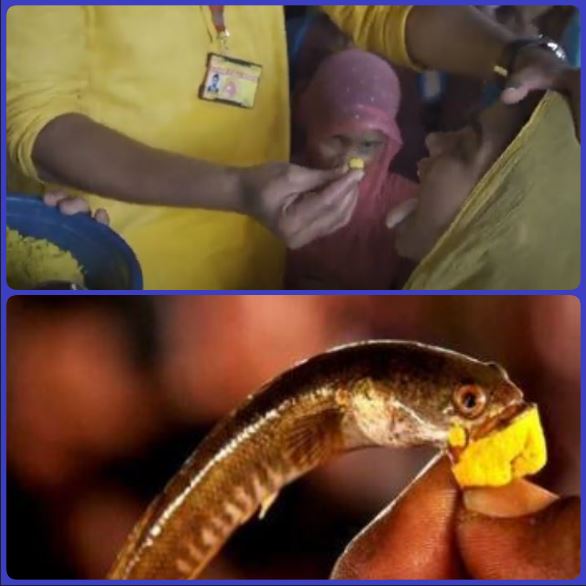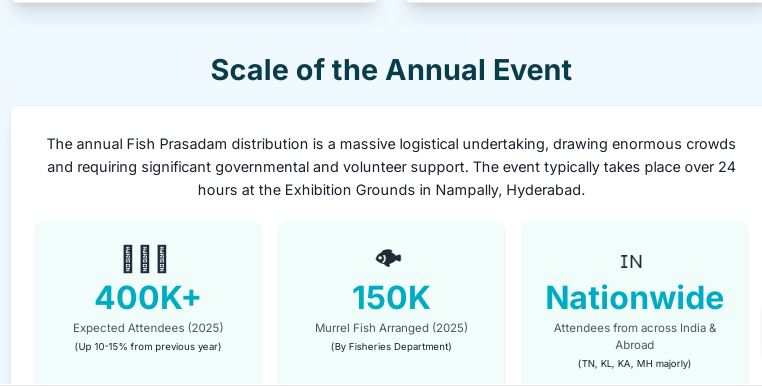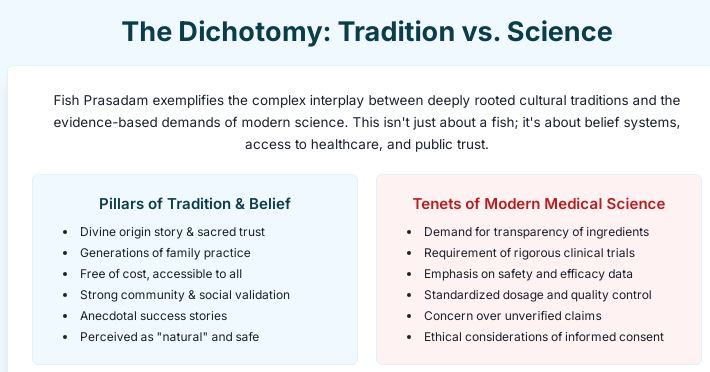
Vihar Vaishnav: Hyderabad, a city steeped in history and vibrant culture, becomes the stage for an extraordinary annual event that draws hundreds of thousands: the ongoing distribution of ‘Fish Prasadam’ on 8th and 9th of June.
Far from a conventional medical procedure, this centuries-old practice involves swallowing a live murrel fish, believed by its proponents to be a miraculous cure for asthma and other respiratory ailments. Yet, this deep-rooted tradition exists in a fascinating, often contentious, dance with the scrutiny of modern science, creating a significant divide that encapsulates broader debates on traditional medicine, public health, and societal belief.
The Deep Roots of a Sacred Tradition: The Bathini Goud Legacy
The story of Fish Prasadam begins in 1845, rooted in the lore of the Bathini Goud family. According to their narrative, a Hindu saint, pleased with the family’s devotion and service, revealed a secret herbal formula to Veeranna Goud. The saint’s injunction was clear: the formula must remain secret, never be commercialized, and be administered free of charge for the public good. This divine origin story and the family’s unwavering commitment to its altruistic distribution are central to the Prasadam’s enduring appeal and the unwavering trust placed in the Bathini Goud lineage. For over 180 years, the family has dutifully administered this remedy, passing down the closely guarded formula through generations, maintaining its mystique and reinforcing its spiritual sanctity.
The administration of the Fish Prasadam is a precise and ritualistic affair. It typically occurs during the auspicious Mrigasira Kartika star, which falls in early June, marking the onset of the monsoon. The process unfolds as follows:
1. Herbal Paste Preparation: The Bathini Goud family meticulously prepares a secret yellowish herbal paste. The exact composition of this paste remains the most fiercely guarded secret, central to the remedy’s efficacy claims.
2. Insertion into Live Fish: This paste is carefully inserted into the mouth of a live murrel fish, typically small, ranging from 2 to 7 centimeters in length. The choice of murrel fish is specific to the tradition.
3. Patient Swallows Fish: The patient then swallows the live fish, often without water, in a single gulp. Proponents believe the wiggling of the live fish as it passes down the throat helps to clear respiratory passages and deliver the herbal concoction effectively.
For individuals who cannot consume fish, or those who are vegetarian, a separate herbal paste mixed with jaggery is offered.
Following the administration, a strict 45-day dietary regimen is recommended, often requiring the avoidance of certain foods and conditions. The full treatment is advised for at least three consecutive years to achieve purported lasting effects. This meticulous adherence to tradition, combined with the familial devotion, transforms the event from a mere health intervention into a profound cultural and spiritual pilgrimage for many attendees.

Beyond governmental efforts, numerous volunteer organizations, such as the Badri Vishalal Pannalal Pitti Charitable Trust and Agarwal Seva Dal, contribute significantly. They provide free food, water, medical aid, and assist in crowd control, demonstrating a massive community involvement that highlights the event’s deep societal acceptance. This extensive logistical and volunteer support implicitly positions the Fish Prasadam as a de facto public health phenomenon, regardless of its scientific standing. It raises critical questions about the allocation of public resources and the implicit endorsement given to an unproven practice.
Conflicting Narratives: Claims vs. Scientific Scrutiny
At the heart of the Fish Prasadam debate lies a stark dichotomy between the fervent claims of its proponents and the rigorous demands of modern scientific validation.

Medical and Scientific Skepticism:
Conversely, the mainstream medical and scientific communities express profound reservations about Fish Prasadam. Their skepticism is rooted in several fundamental concerns:
• Lack of Rigorous Clinical Trials: The most significant objection is the complete absence of scientific validation for the Prasadam’s efficacy. There have been no randomized, controlled, double-blind clinical trials – the gold standard for medical research – to objectively assess its effectiveness against placebos or conventional treatments.
• Undisclosed Ingredients: The secrecy surrounding the herbal paste’s composition is a major impediment. Without knowing the ingredients, it is impossible for scientists to assess its safety, potential interactions with other medications, or even to understand any possible physiological mechanisms of action.
• Safety Concerns: Administering a live fish, particularly to children or individuals with compromised health, carries inherent risks, including choking hazards or potential infections.
• Placebo Effect: Medical professionals suggest that any perceived benefits might largely be attributed to the powerful placebo effect. The strong belief in the remedy, the collective positive energy of the mass event, and the hope for a cure can indeed induce genuine, albeit temporary, physiological improvements.
• Statements from Experts: Leading medical figures, such as Dr. Ajit Vigg from Apollo Hospital, have publicly stated, “There is no evidence that it works. In my 20-25 years of practice, I haven’t seen a single patient whose condition improved or was cured by the fish medicine.”
• Animal Rights Concerns: Animal rights activists have also raised ethical concerns regarding the use of live fish in the practice, citing potential cruelty.
While some preliminary lab tests have indicated that the herbal paste may not contain overtly harmful substances or that heavy metals are within permissible limits, the lack of complete transparency and rigorous clinical data remains a formidable barrier to its acceptance within the evidence-based medical paradigm.
Legal and Ethical Quandaries
The Fish Prasadam phenomenon occupies a precarious regulatory grey area within India’s legal framework. It operates largely outside the stringent regulations governing modern pharmaceutical drugs and even the more flexible guidelines for recognized traditional Indian systems of medicine (AYUSH).
The Indian Medical Association (IMA) has been a vocal critic, challenging the practice under the Drugs and Magical Remedies (Objectionable Advertisements) Act, 1954. They argue that administering an undisclosed medicine is illegal and that ingredients must be publicly declared for safety and transparency. The IMA has consistently called for prosecution of the Bathini Goud family under this act and demanded that the government cease its logistical and financial support for the event, viewing it as an implicit endorsement of an unscientific practice.
Beyond legality, the practice raises significant ethical dilemmas:
• Informed Consent: Without full disclosure of ingredients and a clear understanding of potential risks and benefits, true informed consent from patients becomes challenging.
• Patient Abandonment of Proven Treatment: There is a grave concern that patients, particularly those with severe asthma, might delay or abandon scientifically proven treatments (like inhalers, corticosteroids) in favor of the Fish Prasadam, potentially leading to exacerbation of their condition and severe health consequences.
• Government’s Role: The extensive government support for the event creates a paradox. While intended for crowd control and public facilitation, it inadvertently lends legitimacy to a practice that lacks scientific backing, potentially confusing the public about what constitutes validated healthcare.
• Socio-Economic Factors: The enduring popularity also highlights deeper societal issues, including a potential trust deficit in mainstream healthcare, economic barriers to accessing conventional treatments, and the cultural appeal of traditional remedies.
Bridging the Divide: A Path Forward?
Navigating the complex landscape of Fish Prasadam requires a multi-pronged approach that acknowledges both its cultural significance and the imperatives of public health and scientific rigor.
Imperative for Scientific Research:
The most crucial step forward lies in conducting rigorous, independent scientific research. Key areas for investigation include:
• Clinical Trials for Efficacy: Well-designed, controlled clinical trials are essential to objectively determine if the Fish Prasadam has any measurable effect on asthma beyond a placebo.
• Herbal Paste Ingredient Analysis (Safety & Mechanism): Detailed chemical analysis of the herbal paste is needed to identify all components, assess their pharmacological properties, and determine any potential side effects or long-term health impacts. This could potentially reveal active compounds.
• Knowledge, Attitude, and Practices (KAP) Studies: Research into the beliefs, attitudes, and practices of attendees could provide valuable insights into why individuals choose this remedy, their expectations, and their understanding of its scientific standing.
Such research, if conducted transparently and ethically, could provide objective data to inform public health strategies, regulatory decisions, and individual patient choices.
Recommendations for Stakeholders:
• For Public Health Authorities & Government:
o Implement balanced, evidence-based communication campaigns about asthma management.
o Establish clear regulatory frameworks for traditional remedies that are widely consumed but lack formal validation.
o Re-evaluate the allocation of public resources to events lacking scientific merit.
o Actively facilitate and support independent scientific research into the Prasadam.
o If efficacy is proven, explore pathways for ethical integration into recognized traditional medicine systems like AYUSH.
• For Scientific & Medical Community:
o Prioritize and actively seek funding for rigorous clinical trials and comprehensive ingredient analysis.
o Engage in respectful, collaborative dialogue with the Bathini Goud family and traditional practitioners to understand their perspective and potentially encourage data sharing.
o Conduct more comprehensive KAP studies to understand the socio-cultural context of the practice.
• For Individuals Considering Treatment:
o Be fully aware of the lack of scientific validation and the undisclosed nature of the ingredients.
o Always consult qualified medical doctors for the diagnosis and management of asthma.
o Critically, never stop prescribed modern medical treatments without explicit medical advice from a doctor.
o Carefully weigh the potential risks (choking, unknown ingredients) against the unproven benefits.
Conclusion: A Complex Cultural Phenomenon
Hyderabad’s Fish Prasadam stands as a compelling testament to the enduring power of tradition, faith, and hope in the face of chronic illness. It is a unique cultural phenomenon that mobilizes massive public and governmental resources annually. However, it also serves as a potent microcosm of the broader global challenge: how to reconcile revered cultural practices with the imperative of evidence-based healthcare and scientific scrutiny.
Until rigorous, transparent scientific studies can unequivocally prove its safety and efficacy, the Fish Prasadam will remain a fascinating example of the ongoing tension between deeply held beliefs and the demands of modern medicine. Bridging this divide requires not just scientific inquiry, but also empathetic dialogue, public education, and robust regulatory frameworks that can safeguard public health while respecting diverse cultural practices.
![]()
